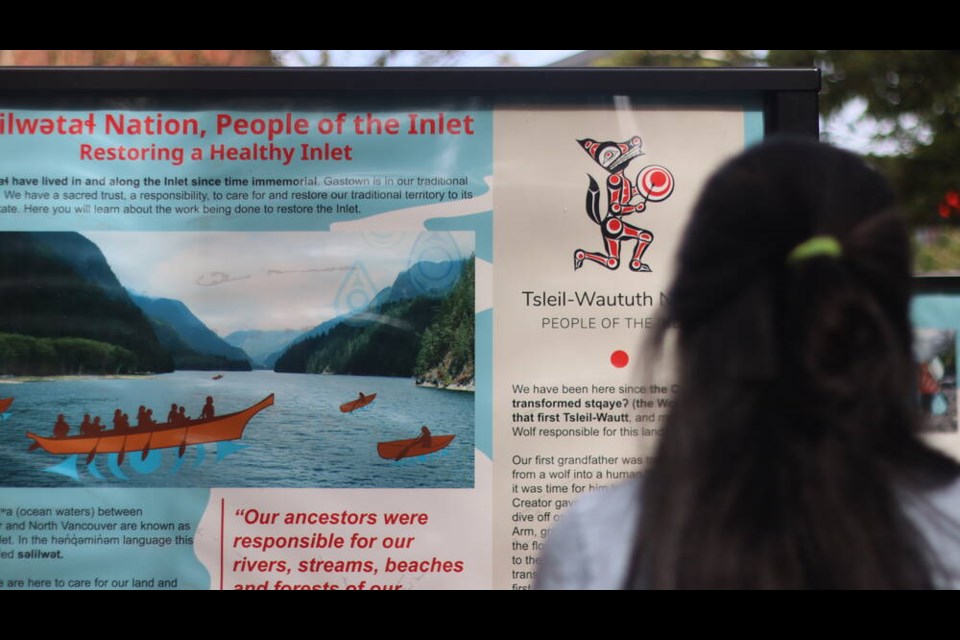Gastown has been given a pedestrian-only rejuvenation and a design makeover that nods to the area’s Indigenous history.
On July 4, the S岣祑x瘫wú7mesh Úxwumixw (Squamish Nation) and s蓹lilw蓹ta涩 (Tsleil-Waututh Nation) joined the City of Vancouver in reopening Water Street and kicking off its pedestrianized pilot.
Maple Tree Square to Cambie Street. will be open to local traffic only while Maple Tree Sq. and Water St. from Cambie to Richards St. will be car-free until the end of August, with the area set to host expanded patios with more seating, stalls, live performance and events.
Beyond going car-free, there has been an overhaul to the street's esthetics, with Indigenous artwork, storytelling boards and signs paying homage to the culture and history of the three, host First Nations.
“We have been out of sight and out of mind on our own lands, for far too long,” said Sxwixwtn (Wilson Williams) Squamish Nation elected council member. “Lekleki (Gastown) is one of the most historic neighbourhoods in K’emk’emeláy虛 (Vancouver), but until now, has not reflected the deep connection local Indigenous peoples have to the area.”
Bringing a splash of vibrant culture and colour to the area are planter art wraps crafted by elementary school-aged Squamish Nation children from Xweme虂lch’stn Etsimxwawtxw (Capilano Little Ones School), designed in honour of this year’s Earth Day, and Tsleil-Waututh artists Jordan Gallie, Jonas Jones, and Zac George.
Alongside them, storytelling boards share the history of the Nations, Gastown’s place name in the S岣祑x瘫wú7mesh Sníchim (Squamish language), welcome translations in both the Squamish and Tsleil-Waututh languages, and advice on what residents can do to help restore the Tsleil-Waututh Nation protected Burrard Inlet.
Williams said he is “immensely proud” in seeing the Nation’s history shared in the Squamish language, along with the ‘beautiful artwork” from the Nation’s me虂n虛men (children).
“I truly hope this initiative is just the first of many in making our beautiful city a more inclusive place for all.” he said.
Gallie, who helped produce the colourful designs for the plant pots alongside other Tsleil-Waututh Nation artists, hopes the signs are the first introduction visitors receive from the downtown area.
Gallie has been practicing Indigenous art work since 2012 via all manner of mediums, from jewellery to printmaking, but public art is especially effective in its ability to influence and inform passersby, he said. For everyone visiting the area, whether they're stepping off a cruise ship or coming from across town, the signage and artwork provides “immediate education” on the local host Nations, he said.
For young and budding First Nations creatives, Gallie said he hopes the signs encourage them to pick up a pencil or paintbrush in the same way he was once influenced by public art to embark on his own artistic journey.
“Nine years ago, I went to the Museum of Anthropology to see all of the First Nations artwork and it was just mind blowing to me," he said, adding how the experience sparked within him an interest in becoming an artist. Gallie said his "main purpose" is to create that opportunity for someone else.
The Tsleil-Waututh Nation's Chief Jen Thomas said she looks forward to seeing Water Street. become a “more welcoming space,” and a lively hub for learning.
The pilot is part of the Tsleil-Waututh's ongoing collaboration with the City of Vancouver to support making Gastown "more people-friendly", she said, but "at the same time, this work is making our Tsleil-Waututh Nation culture and history more visible on our traditional lands, alongside our relatives Musqueam and the Squamish Nation."
Running until the end of August, the pilot will also coincide with a number of summer events designed to make use of the devoid of traffic streets. Live music showcases will will take place every Thursday and community event Meet Me in Gastown is set for August 15.
Mina Kerr-Lazenby is the North Shore News’ Indigenous and civic affairs reporter. This reporting beat is made possible by the .




